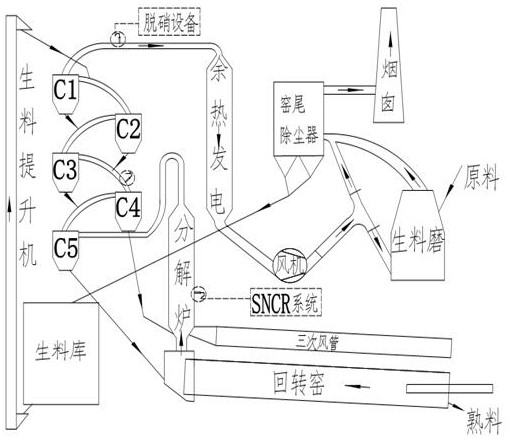Cement kiln denitration discharge method
A cement kiln and denitrification technology, applied in the field of air pollution control, can solve problems such as poor actual efficiency, unreachable exhaust gas temperature, and high temperature in the reaction zone
- Summary
- Abstract
- Description
- Claims
- Application Information
AI Technical Summary
Problems solved by technology
Method used
Image
Examples
Embodiment 1
[0031] A 4000t / d cement plant in Shandong adopts a 5-stage preheater. The kiln tail gas is discharged from the C1 preheater and flows through the waste heat boiler (or humidification tower), high-temperature fan, (raw meal mill), bag collector The dust collector, kiln tail fan, and chimney are discharged into the atmosphere. Among them, the discharge temperature of the C1 preheater is 330-420°C, and the SNCR denitrification system is installed at the calciner. Normally, the kiln tail flue gas is NO X The emission is stable at 250-320mg / m 3 , to meet the national emission standards. Among them, Shandong has imposed an environmental protection tax since January 1, 2018, of which sulfur dioxide and nitrogen oxides are 6 yuan per pollution equivalent (0.95KG). X About 1052 tons, SO 2 About 118 tons; plus smoke and dust emissions, the environmental protection tax paid in 2018 was about 8.06 million yuan. In order to reduce environmental protection costs, at the same time reserve...
Embodiment 2
[0035] A 2500t / d cement plant in Anhui adopts a 5-stage preheater. The kiln tail gas is discharged from the C1 preheater and flows through the waste heat boiler (or humidification tower), high-temperature fan, (raw meal mill), bag collector The dust collector, kiln tail fan, and chimney are discharged into the atmosphere. Among them, the SNCR denitrification system is installed at the calciner. Under normal conditions, the kiln tail flue gas NO X The emission is stable at 200-300mg / Nm 3 , to meet the national emission standards. In April 2020, the Provincial Environmental Protection Bureau required local cement companies to implement ultra-low emissions on October 1, 2020, among which the kiln tail gas NO X The emission is 100mg / Nm 3 , All those that fail to meet the ultra-low emission standards will be shut down for rectification. After the enterprise adopts the scheme of this embodiment, NO X The emission is stable at 30-80mg / Nm 3 , less than 100mg / Nm 3 Emission Standa...
Embodiment 3
[0038] A 2500t / d cement plant has adopted SNCR denitrification at present, and under normal conditions the kiln tail flue gas is NO X The emission is stable at 220-350mg / Nm 3 , SO 2 The emission is stable at 22-150mg / Nm 3 , Dust 15-22mg / Nm 3 , to meet the national emission standards. Due to the revision of provincial emission standards, dust is required to be less than 35mg / Nm 3 , SO 2 Emission less than 35mg / Nm 3 , NO X Less than 100mg / Nm 3 . Adopt the scheme of this embodiment, NO X The emission is stable at 30-80mg / Nm 3 , SO 2 Emission 10-20mg / Nm 3 .
[0039] The specific process of this embodiment scheme is as follows: using cerium oxide powder (325 mesh), copper oxide powder (325 mesh), iron oxide (325 mesh), manganese oxide (325 mesh), manganese sulfate crystal, iron sulfate crystal, urea, Prepare a catalyst solution with Tween 80 and water in a mass ratio of 1:2:6:6:20:10:45:15:300; the catalyst microsuspension contains solid denitrification catalytic comp...
PUM
 Login to View More
Login to View More Abstract
Description
Claims
Application Information
 Login to View More
Login to View More - R&D
- Intellectual Property
- Life Sciences
- Materials
- Tech Scout
- Unparalleled Data Quality
- Higher Quality Content
- 60% Fewer Hallucinations
Browse by: Latest US Patents, China's latest patents, Technical Efficacy Thesaurus, Application Domain, Technology Topic, Popular Technical Reports.
© 2025 PatSnap. All rights reserved.Legal|Privacy policy|Modern Slavery Act Transparency Statement|Sitemap|About US| Contact US: help@patsnap.com

